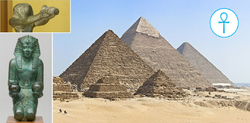- Retour accueil
- Vous êtes ici : Blog The Pyramids of the Cold The Pyramids of the Cold Section 33 • Thoth's Medes-Blade and the Writing metaphor
The Pyramids of the Cold Section 33 • Thoth's Medes-Blade and the Writing metaphor
Publié par Bruno Coursol dans The Pyramids of the Cold le 01/04/2023 à 09:58
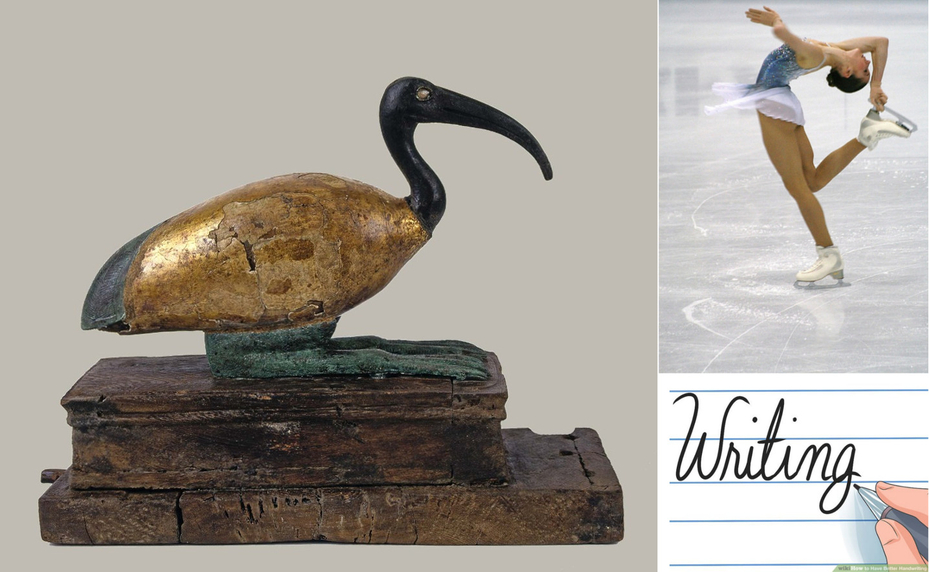
Polina Korobeynikova (Russia) at the 2012 Figure Skating World Championships; posted by Luu: https://en.wikipedia.org/wiki/Glossary_of_figure_skating_terms#/media/File:2012_WFSC_07d_843_Polina_Korobeynikova.JPG
Writing image: https://www.wikihow.com/Have-Better-Handwriting#/Image:Have-Better-Handwriting-Step-11.jpg
The Pyramids of the Cold Section 33 • Thoth's Medes-blade and the writing metaphor
In summary: this Section is about the deciphering of god of knowledge Thoth and is correcting as well two inaccuracies made in previous Sections regarding Son of Horus Hapy and Anubis.
• the first interpretation of jackal-black-headed god Anubis wasn't fully accurate, because there is a distinction which has to be made between the glorification of the impactor' sledge (its entire structure), and its runners. The deciphering of Thoth, allows us now to narrow the area of competence of Anubis in the deification of the sledge alone; because if Thoth has been referred to as a "mediator" god who symbolized writing, truth and "straightness" for ancient Egyptians, it is because of the way the sledge runners of the impactor were moving into their U-shaped wooden tracks.
If Anubis and Wepwawet are the deifications of the impactor's sledge, that is Thoth who is the deification of the sledge runners; and just like we call "knife" the part of our very modern sledge runner which is actually in direct contact with the ground, Thoth himself also has his own knife: the "knife-medes".
• the same way, Thoth's allows us a better understanding of Son of Horus god Hapy: we've already seen that Hapy is all about running water because of his "Great Runner" epithet, but we can assume today that Hapy is actually only about the running waters on which was moving the sledge runners of the impactor.

"Thoth, God of Writing and Knowledge, as a Baboon" at the MFAH Museum of Fine Arts, Houston: https://emuseum.mfah.org/objects/48125/thoth-god-of-writing-and-knowledge-as-a-baboon#
"Sarcophage d'ibis aux ailes repliées représentant le dieu Thot. Le corps est en bois de houx doré à la feuille. Les pattes gravées en décor de "nid d'abeille" et le long bec recourbé sont un alliage d'argent et de cuivre, les yeux sont incrustés d'un verre grenat cerclé d'or". Musée d'archéologie méditerranéenne de la Vieille Charité à Marseille: https://fr.m.wikipedia.org/wiki/Fichier:Sarcophage_Ibis_-_Mus%C3%A9e_vieille_charit%C3%A9.jpg
33.01 Why the hell is Thoth associated with both the baboon and the ibis bird?
Thoth is indeed a very peculiar deity, because he can be represented into not one but two different animals: the baboon and the ibis bird. To my knowledge, this is unique among ancient Egyptian deities, and I'm surprised that egyptologists don't seem to be alarmed or at least concerned of that fact: they simply refer to this "curiosity" as if it was all but natural.
But of course, it can't be; how could one single god be represented either in a baboon form or in an ibis form?
The truth is that it isn't possible, and the reason is because Thoth is not just about one "thing": Thoth is about two different things which were supposed to be associated one with each other.
We'll see in this Section that Thoth is the deification of not just the sledge runners of the impactor of the Great Pyramid, but the deification of the "global operation" of the sledge runners: Thoth is the glorification of both the sledge runners and the water without which the runners wouldn't be able to function in the first place.
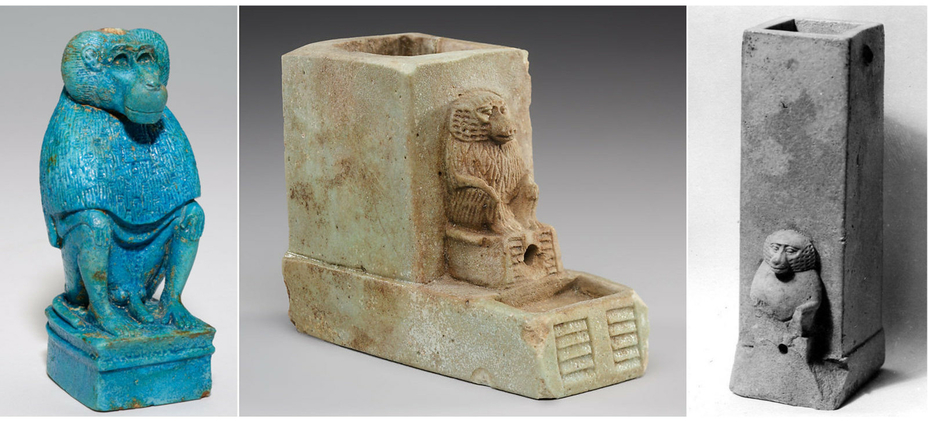
"Baboon (Moon God Thoth), 7th - 6th century BCE", at the MIA, Minneapolis Institute of Art: https://collections.artsmia.org/art/126884/baboon-ancient-egyptian
"Water Clock Decorated with a Baboon" at the Metropolitan Museum of Art, New-York: https://www.metmuseum.org/art/collection/search/572126
"Clepsydra or water clock with squatting baboon", also at the MET: https://www.metmuseum.org/art/collection/search/549190
33.02 "Baboon" Thoth and the water clocks are all about water
We've already seen in previous Sections that the baboon representations were all about water; and that it is explaining why so many baboon figures are in a bright and vivid blue color and why baboons are represented in so many water clocks, in which the water was supposed to slowly drip from the baboon's penis.
Baboon = Water. There is nothing new here.
But Thoth isn't just any baboon: Thoth is the Baboon god, and he isn't any kind of water, because he was directly associated with Ra. It means that Thoth is about water related to the operation of the impactor Ra.
What is important about Ra, is that he is all about the wooden part of the impactor; Ra is about the "vessel" in which is nestled the Osiris stone; so Thoth isn't about the power of the impactor, but about how it moved in the Gallery, like a "solar boat".
"Thoth could be shown as a “beautiful” baboon or as an ibis or an ibis-headed man. Ra was said to have created the baboon form of Thoth to shine in the night sky and the ibis form to act as a messenger between earth and heaven." https://egypt-museum.com/statue-of-thoth-with-priest/
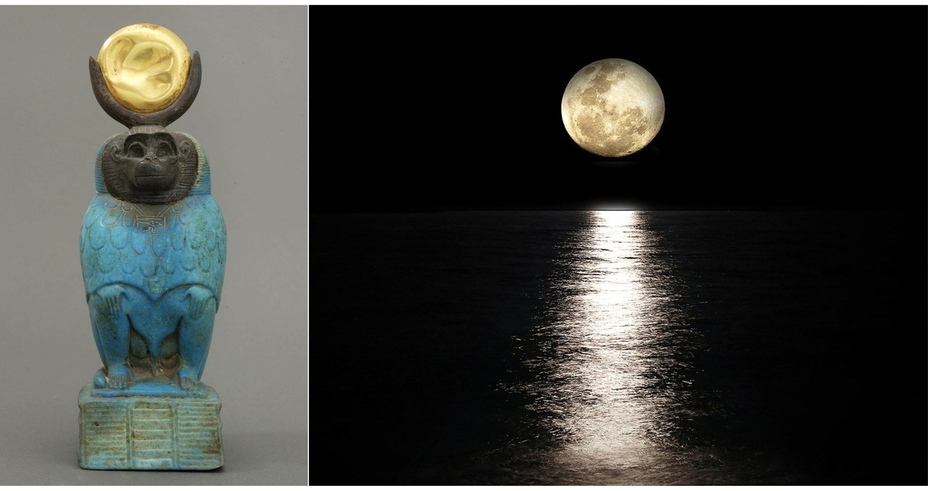
Figurine of Thoth in his baboon form, E 17496 at the Louvre Museum, Paris: https://collections.louvre.fr/en/ark:/53355/cl010006219
Full moon reflecting on water at night, from GPA Photo Archive: https://www.flickr.com/photos/iip-photo-archive/52288510241/in/photostream/
33.03 Baboon Thoth and the reflecting shining moon metaphor
We'll assemble all the pieces that allow us to understand Thoth, farther down this Section, but first let's stay with this same above excerpt, and focus ourselves on the rest of the text.
"Thoth could be shown as a “beautiful” baboon or as an ibis or an ibis-headed man. Ra was said to have created the baboon form of Thoth to shine in the night sky and the ibis form to act as a messenger between earth and heaven." https://egypt-museum.com/statue-of-thoth-with-priest/
I really hope you're not tired of reading about the metaphors that ancient Egyptians used in their glorification of their own scientific accomplishments, and try to understand them, because there are many more to come… and it starts right now with the "reflecting moon" metaphor.
Even if it is known that "Ra was said to have created the baboon form of Thoth to shine in the night sky"; it doesn't imply that Thoth is the moon itself: we've already seen that the baboons were representations of water, and not directly about the moon.
So here, the "shine in the night sky" metaphor about the "moon" god Thoth, is all about how water is reflecting moon light at night; but I don't think it is about the moon reflecting on a large amount of water, like the sea or a lake. If you look to the above photograph of the moon reflecting on water, what is in my opinion, essential is the shape of the reflection: a straight line of reflected light; and I think that this straight line is directly referring to another known characteristic of Thoth:
"In vignettes of the Book of the Dead [Thoth] stands before the scales which weigh the heart of the deceased and record the verdict. This role gave Thoth a reputation for truth and integrity and is seen in the common assertion that a person had conducted his life in a manner "straight and true like Thoth". https://www.worldhistory.org/Thoth/#google_vignette
In the above images, the water below the moon of the second image, is the baboon of the first image. Both images are representing the exact same thing: the reflecting moon, over water.

"This engraving shows Dutch mathematician and physicist Jean Henri van Swinden (1746–1823) demonstrating the generation of electricity to the Felix Meritis Society in Amsterdam. The Felix Meritis Society was founded in the late 18th century to promote the arts and sciences (Felix Meritis translates as "Happiness through Merit")". Barbiers, Pieter Pietersz., and Jacques Kuyper. Courtesy of Science History Institute in Philadelphia : https://digital.sciencehistory.org/works/zg64tm573
"The astronomical ceiling at the Pronaos, outer hypostyle hall in the Temple of Hathor in the Dendera Temple complex, near Dendera, Egypt. : detail of the first Band west from the centre, showing the full healed moon on a pillar depicted as "Wadjet" the Eye of Horus healed by Thoth, who is portrayed at the right." Thanks to Kairoinfo4U : https://www.flickr.com/photos/manna4u/9295311496
Jim Hutton as detective Ellery Queen, posing with a magnifying glass courtesy of NBC Television: https://en.wikipedia.org/wiki/Magnifying_glass#/media/File:Jim_Hutton_Ellery_Queen_1976.JPG
33.04 God of Science and Knowledge Thoth and the magnifying glass
We've actually met Thoth in the previous Sections such as in the Table of Contents, and we've seen that what Thoth is really "worshiping" in a magnificent and colorful relief in the Hathor temple at Dendera, isn't the moon as the academic vision of the scene is trying to explain, but a magnifying glass; and that if there is the Eye of Horus on the glass it is because the magnifying glass is meant for an eye.
And it makes perfect sense to see Thoth with a magnifying glass, as Thoth is the god of science and knowledge.
He [Thoth] was the god of the moon, wisdom, knowledge, writing, hieroglyphs, science, magic, art and judgment. https://en.wikipedia.org/wiki/Thoth

"These images show the crescent of the moon in a one-month period. Due to bad weather, these images were taken within six months. All of the images have been photographed from a fixed location in Rasht, Iran, by Hamed Rajabpour and Nariman Ghorbani: https://commons.wikimedia.org/wiki/File:Lunar_Phases.jpg
33.05 Is the magnifying glass the reason of Thoth being a "moon god"?
The question now is to know why Thoth is also a Moon god, and maybe it is just because the magnifying glass simply does look like the full moon resting on a crescent moon.
We'll see farther down this Section, that Thoth was in possession of a "knife", the knife-Medes, and it is possible that the lunar phases could have been seen as the simple result of the use of this knife-Medes onto the moon.
"Thoth was a Moon god. The Moon not only provides light at night, allowing time to still be measured without the sun, but its phases and prominence gave it a significant importance in early astrology/astronomy. The perceived cycles of the Moon also organized much of Egyptian society's rituals and events, both civil and religious. Consequently, Thoth gradually became seen as a god of wisdom, magic, and the measurement and regulation of events and of time.[30] He was thus said to be the secretary and counselor of the sun god Ra, and with Ma'at (truth/order) stood next to Ra on the nightly voyage across the sky". https://en.wikipedia.org/wiki/Thoth
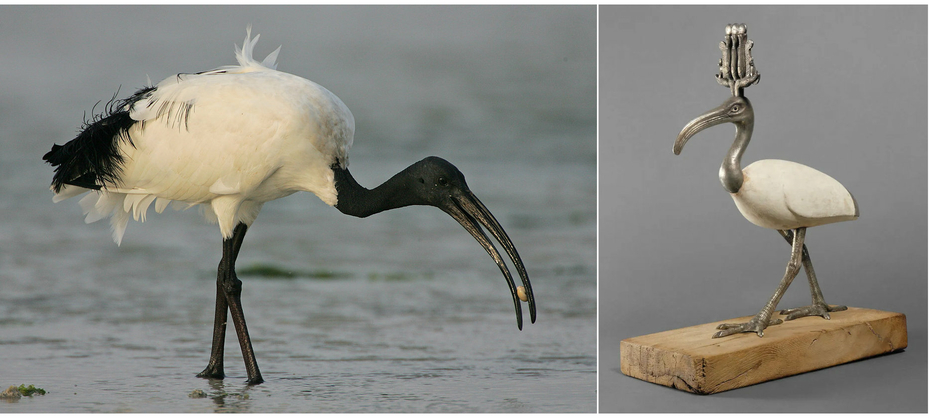
"African Sacred Ibis in the Mida Creek mud flats, Kenya" by Steve Garvie: https://ro.wikipedia.org/wiki/Ibis_sacru_african#/media/Fi%C8%99ier:Threskiornis_aethiopicus_-Mida_Creek_mud_flats,_Kenya-8.jpg
"Statuette of Thoth as an Ibis bird" at the Egypt Museum: https://egypt-museum.com/statuette-of-the-god-thoth-as-an-ibis-bird/#google_vignette
33.06 "He who is like the ibis" metaphor because Thoth was "walking into shallow waters"
Interestingly, there are two types of representations of Thoth as an ibis bird: the standing ones and the recumbent ones; both are telling us two different things as well.
The standing representations of Thoth as an ibis, are about how the bird is walking into shallow waters. Just like in many occasions, the water is the element which is systematically forgotten in ancient Egyptian art.
The ibis bird is about water, and this is the reason why Thoth was described as "He who is like the ibis".
"According to Theodor Hopfner, Thoth's Egyptian name written as ḏḥwty originated from ḏḥw, claimed to be the oldest known name for the ibis, normally written as hbj. The addition of -ty denotes that he possessed the attributes of the ibis. Hence Thoth's name would mean "He who is like the ibis", according to this interpretation." https://en.wikipedia.org/wiki/Thoth
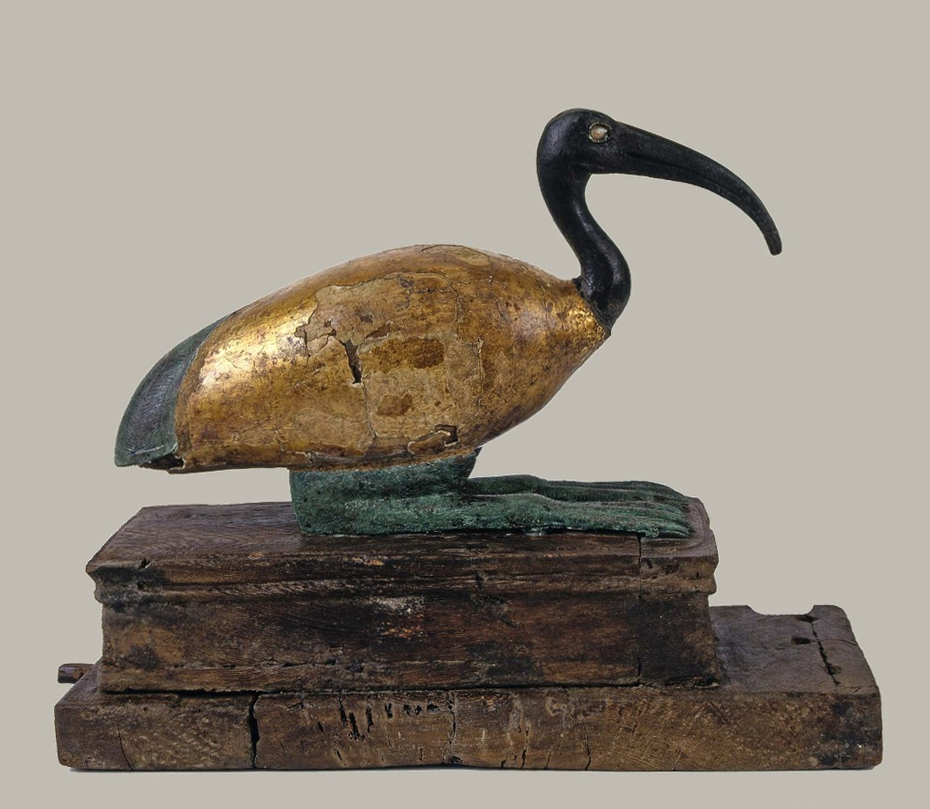
33.07 The extravagant and unnatural legs of Thoth as an ibis bird • 1
"Statuette of an ibis" at the Musei Vaticani, Roma. "The statuette depicts a crouching ibis, a manifestation of the god Thoth, one of the most important deities of the Egyptian pantheon, whose main shrine was situated in the city of Hermopolis Magna in Middle Egypt. The animal’s head, tail and feet are in bronze, whereas the body is made of plastered and gilded wood. It is notable for the particularly refined anatomical rendering of the head, with inlaid vitreous paste for the eyes, as well as the tail and the plumage. The feet are modeled realistically and with particular care." https://www.museivaticani.va/content/museivaticani/en/collezioni/musei/museo-gregoriano-egizio/sala-vi--la-collezione-carlo-grassi/statuetta-di-ibis.html#&gid=1&pid=1
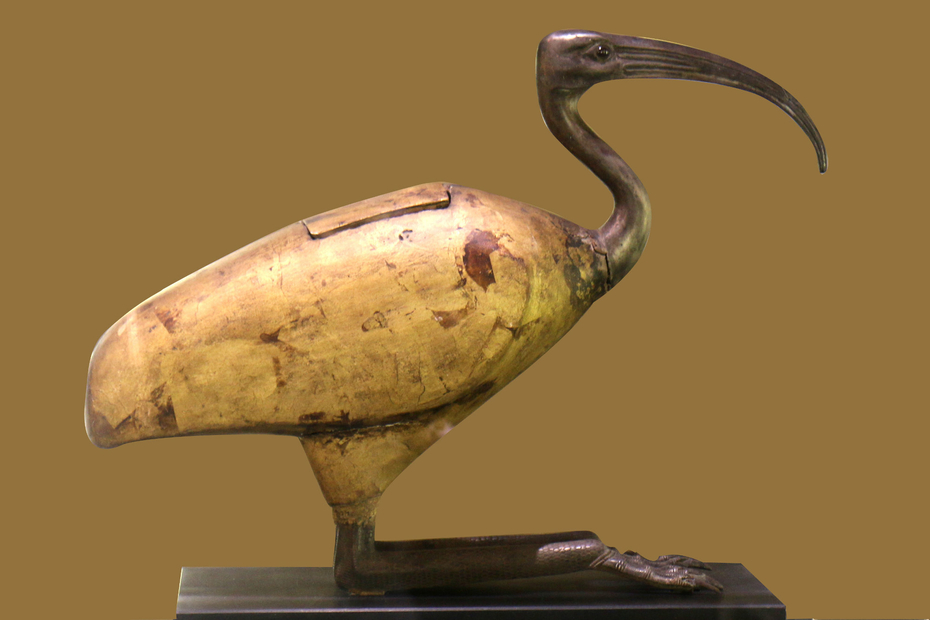
"Sarcophage d'ibis aux ailes repliées représentant le dieu Thot. Le corps est en bois de houx doré à la feuille. Les pattes gravées en décor de "nid d'abeille" et le long bec recourbé sont un alliage d'argent et de cuivre, les yeux sont incrustés d'un verre grenat cerclé d'or". Musée d'archéologie méditerranéenne de la Vieille Charité à Marseille: https://fr.m.wikipedia.org/wiki/Fichier:Sarcophage_Ibis_-_Mus%C3%A9e_vieille_charit%C3%A9.jpg
33.08 The extravagant and unnatural legs of Thoth as an ibis bird • 2
It doesn't show easily on the image, but what is very interesting in the above photograph from the French Vieille Charité Mediterranean Museum in Marseille, is that only the legs of the animal have been admirably detailed; in particular there are hundreds of little honeycomb patterns all other the legs of this little figure (height: 40 cm ; length: 56 cm ; width: 20 cm). It really is a fabulous craftsman job.
If you look at all the recumbent figures of Thoth as an ibis, you'll see that these legs are always the key element, by the attention given to its realization, and their completely unnatural posture: you will never find an ibis with its legs in such a awkward position.
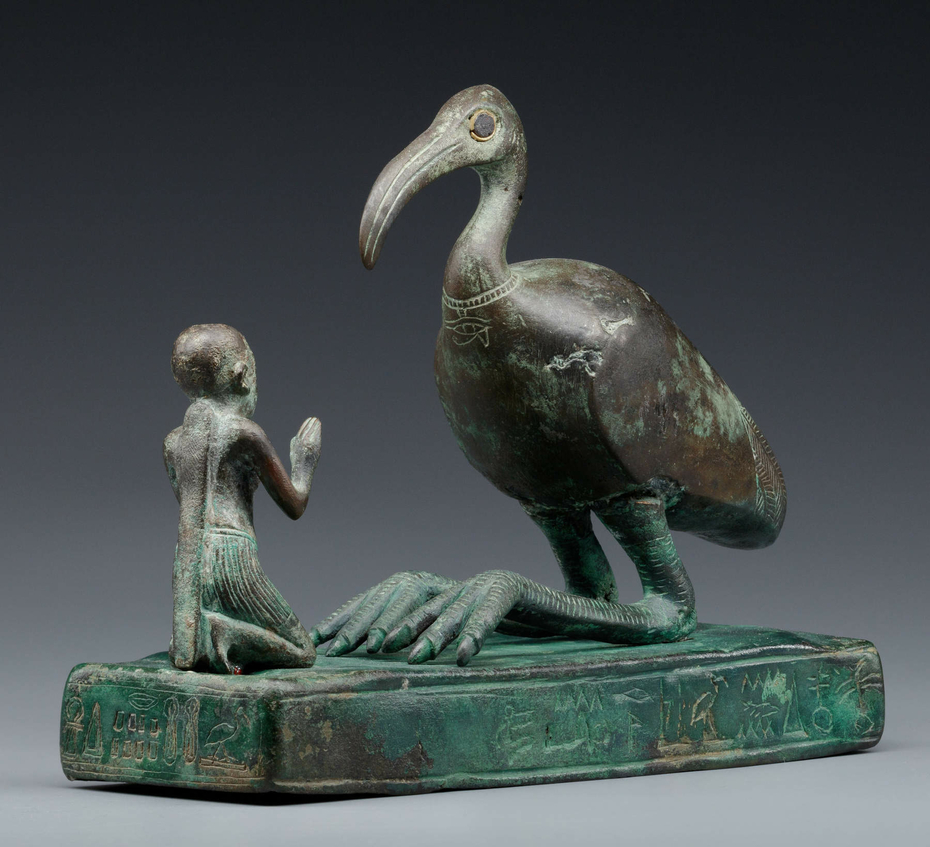
Group statue of Thoth-ibis and devotee on a base inscribed for Padihorsiese, Late Period ca. 700–500 B.C. Metropolitan Museum of Art: https://www.metmuseum.org/art/collection/search/552857
33.09 The extravagant and unnatural legs of Thoth as an ibis bird • 3
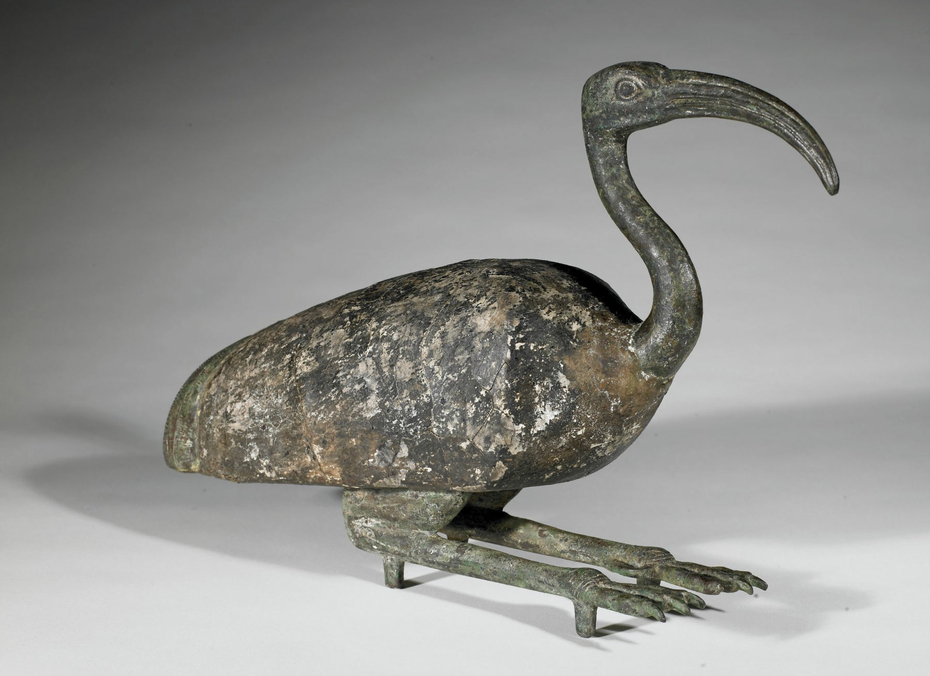
"Ancient Egyptian bronze and wood sculpture" at the Birmingham Museum of Art: https://www.artsbma.org/guide/stop/214/
33.10 The extravagant and unnatural legs of Thoth as an ibis bird • 4
Again here, the important part of the figure are the legs: you will certainly never see an ibis in such an awkward position; but these feet are getting really close to be a perfect representation of sledge runners; it is almost like we can "feel" the artificial rendering and the "speed" which are emanating from these legs.

"Coffin for an ibis, 664-30 BCE or later" at the RISD Museum of Art, Rhode Island School of Design Museum, Providence, Rhode Island: https://risdmuseum.org/art-design/collection/coffin-ibis-57001
33.11 The extravagant and unnatural legs of Thoth as an ibis bird • 5
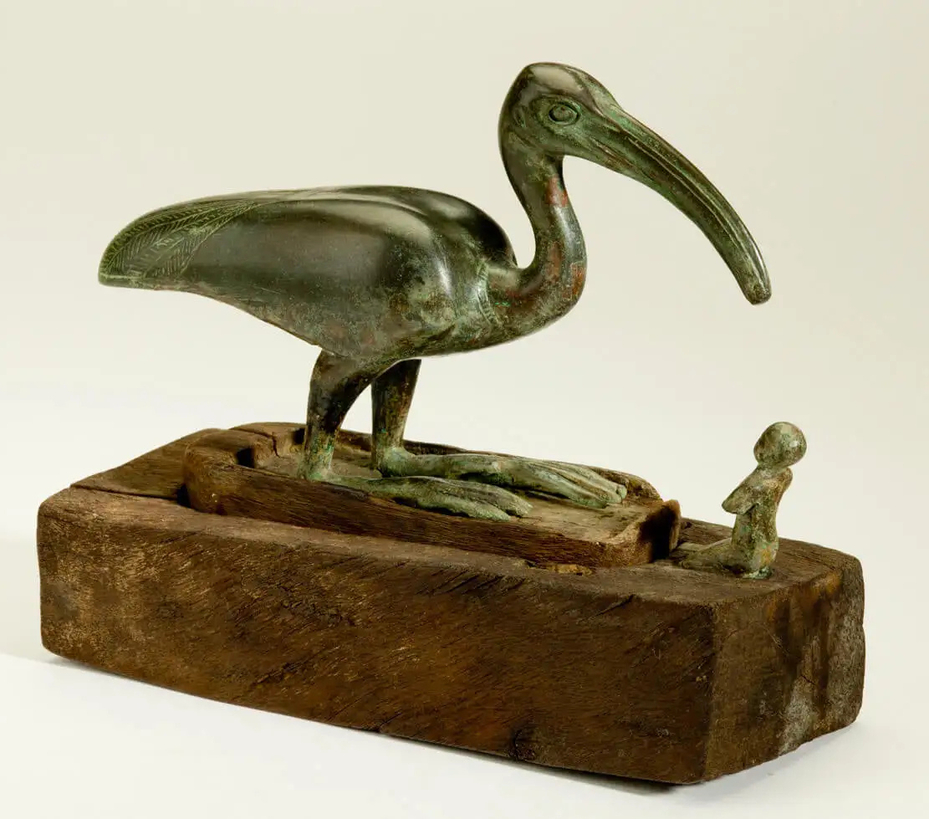
"Statue of Thoth as Ibis with a Priest" at the Egypt Museum. " This bronze statue may have been offered in the temple of Thoth at Hermopolis or one of the numerous sites sacred to this god. The cult of Thoth, god of learning, wisdom, medicine, and writing was popular in pharaonic Egypt. The wooden base is original". https://egypt-museum.com/statue-of-thoth-with-priest/
33.12 The extravagant and unnatural legs of Thoth as an ibis bird • 6: the second aspect of Thoth is about sledge runners
The above figure of Thoth at the Egypt Museum is both unique and fantastic, because it is the only figure of Thoth I know of that is literally revealing its true nature; and this is the same pattern of "encoding" that we've already seen many times: Thoth is actually represented twice in the figure.
• The first representation of Thoth is the ibis, with its magnificent but unnatural legs
• The second representation of Thoth is the hollowed out wooden board on which the bird is standing on.
But the figure doesn't stop at the representation of Thoth: it is the complete operation of the sledge runners which is depicted here: the massive wooden piece, that fits perfectly the "ibis board", that piece is the representation of the tracks.
Just imagine extending this wooden base block, both frontwards and backwards and you can move the ibis board just like the runners were moving into the tracks of the Gallery.
In other words, it is not by accident that the ibis is looking like surfing a board: he really is. In some ways, the runners were surfing into their tracks.
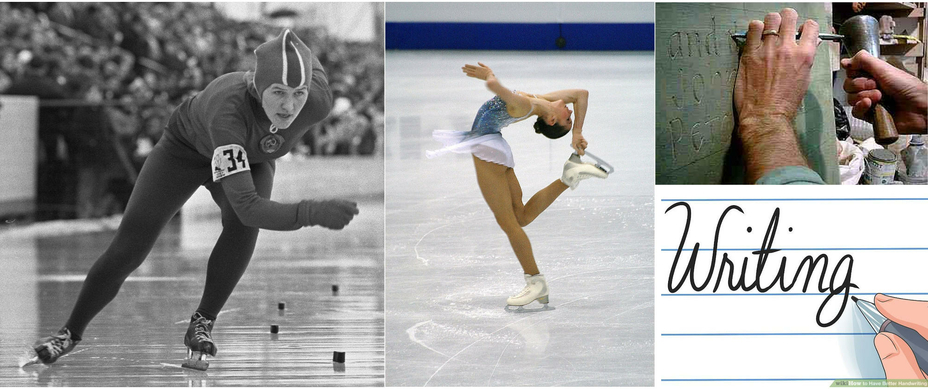
Lidiya Pavlovna Skoblikova at the World Skating Championships in Deventer in 1967, by Eric Koch: https://en.wikipedia.org/wiki/Lidiya_Skoblikova#/media/File:Lidiya_Skoblikova_1967.jpg
Polina Korobeynikova (Russia) at the 2012 Figure Skating World Championships; posted by Luu: https://en.wikipedia.org/wiki/Glossary_of_figure_skating_terms#/media/File:2012_WFSC_07d_843_Polina_Korobeynikova.JPG
" Stone carving and tools – the basics", by John Pitt": https://johnpittcreative.com/2010/11/21/stone-carving-and-tools-the-basics/
Handwriting image: https://www.wikihow.com/Have-Better-Handwriting#/Image:Have-Better-Handwriting-Step-11.jpg
33.13 Thoth and the "stroke of a pen" Writing metaphor
The fact that Thoth is the glorification of the sledge runners of the impactor of the Grand Gallery, explains beautifully why he became the god of writing and knowledge, and why he was referred to as the "messenger" and the "mediator".
Of course, the most beautiful of all metaphors about Thoth is about how he became the god of writing: even today, we are using the exact same metaphor when ice skaters are "writing" beautiful arabesques on a skating-rink.
And because the hieroglyphs were invented especially to describe (but also to hide) every part of the scientific accomplishments, Thoth also became the god of knowledge.
There is also most probably a link that has to be made between the ice skating-rink that explains in modern terms the Thoth writing metaphor, and the glass of the magnifying glass of the god of science Thoth.
The operation of the sledge runners could be seen like writing arabesques on the ice (that is a modern way of understanding the metaphor), but of course ancient Egyptians would most probably use another metaphor of their time, and they would have think of the nib of a plume writing onto paper or a chisel carving a stone and writing hieroglyphs.
Today, we could use another metaphor: "the stroke of a pen".
"Thoth created the written word people used to record their history and keep track of their daily lives. According to some stories, Thoth invented the word and gave it to humanity while, in others, Thoth was the creator and his consort Seshat gave words to the people. In still other variations, Thoth was the creator but Osiris or Isis gave words to humanity." https://www.worldhistory.org/Thoth/#google_vignette
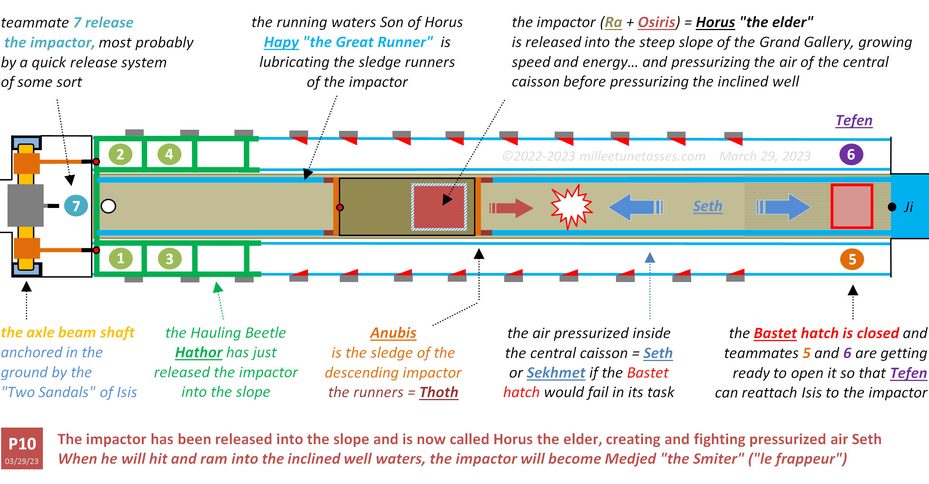
33.14 Operation of the Grand Gallery of the Great Pyramid of Egypt, Position P10 Top View
The impactor has been released into the slope and is now called Horus the elder, creating and fighting pressurized air Seth. When he will hit and ram into the inclined well waters, the impactor will become Medjed "the Smiter" ("le frappeur"). Last updated March 29, 2023. All the operating phases of the Grand Gallery's functioning in Section 31.
33.15 The "Sharp One" knife-medes that posseses Thoth is the runner which is "fighting" Seth
We've already seen that when Seth is described as fighting both Osiris and the Great Serpent Apep, it is because Seth is the pressurized air that is created inside the central caisson of the Grand Gallery: before pressurized air Seth can force his way through the inclined well waters, that is the fall of the impactor which is creating this pressurized air.
Now, with Thoth coming into play by being the deification of the sledge runners of that same impactor, the fight between Seth and Osiris can also be seen as a fight between Seth and Thoth.
"The personality of Thoth, linked to that of Seth, […] may have been determined by the inclination of both gods towards violence […] Some passages of the PT [Pyramids Texts] would confirm precisely such aspect in Thoth because of his possession of the knife-medes "the sharp one" […] Note, however, that in the quoted sentences of the PT the reference to the knife-medes close to its possessor, i.e. Thoth, is puzzling as it does not seem clear whether it was the knife or the god himself (personifying the knife) what came forth from Seth. Nethertheless, it is perhaps not by accident but intentional such a close - one might say coalescent - interrelationship between possessor (=Thoth) and possessed object (= knife-medes), i.e. between the god and an essential part of him […]"
Journal article "Thoth in PT [218] 163d and PT [219] 175a: From the Shadows of Power", available on JSTOR* and published by Lucas Baqué-Manzano; page 18 and 19: https://www.jstor.org/stable/44654385
* JSTOR's articles are available to anyone, but you first need to register as "independent researcher"
33.16 Thoth as an ibis was indeed supposed to interact with Horus when "floating" into water
From the same article on JSTOR, page 22: "Concerning the ibis, it was this bird who ate from the divine body in the water. Horus was on the flood, (floating) on the river, unaware of (lit. far with respect to) the evil deed (committed) in Upper Egypt. […] Then this bird ate from him (Osiris) in the water and he (the ibis) was resting on his belly once he was satiated."
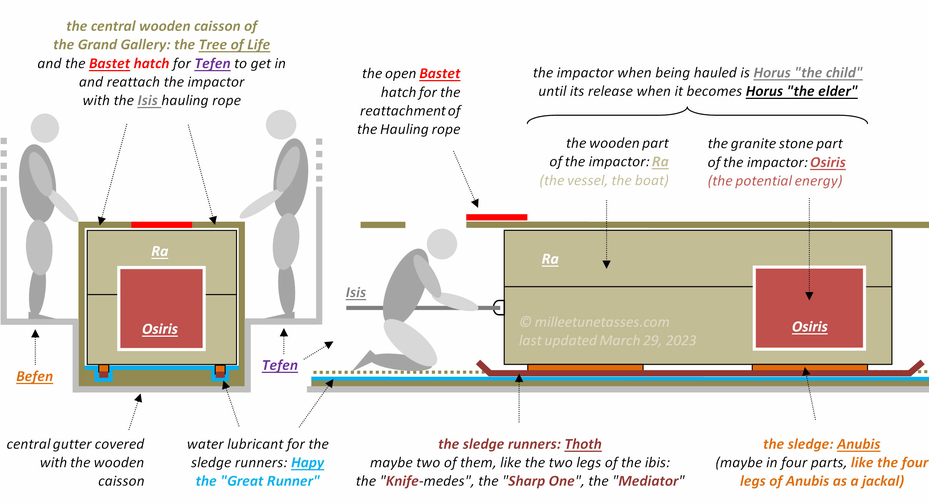
33.17 The design of the composite impactor of the Great Pyramid of Giza
Of course, these draws are largely adapted and simplified; when Tefen got into the central caisson, the impactor would probably be more or less floating inside the waters of the inclined well.
33.18 Seth fighting Osiris and Horus
"In the Osiris myth, the most important Egyptian myth, Set is portrayed as the usurper who murdered and mutilated his own brother, Osiris."; "An important element of Set's mythology was his conflict with his brother or nephew, Horus". https://en.wikipedia.org/wiki/Set_(deity)
33.19 Seth fighting Apep and protecting Ra by "taking on the guise of Horus"
"Set had a positive role where he accompanies Ra on his barque to repel Apep"; "Set was depicted standing on the prow of Ra's barge defeating the dark serpent Apep. In some Late Period representations, such as in the Persian Period Temple of Hibis at Khargah, Set was represented in this role with a falcon's head, taking on the guise of Horus. In the Amduat, Set is described as having a key role in overcoming Apep." https://en.wikipedia.org/wiki/Set_(deity)
33.20 Thoth the messenger and mediator
Another way of seeing the Thoth sledge runners, is by associating him with the role of a simple intermediary between the tracks of the Gallery and the impactor itself: Thoth can be seen as a messenger, or as a mediator.
"Thoth is an unusual god. Though some stories place him as a son of Ra, others say that Thoth created himself through the power of language. He is the creator of magic, the inventor of writing, teacher of man, the messenger of the gods (and thus identified by the Greeks with Hermes) and the divine record-keeper and mediator." http://www.touregypt.net/godsofegypt/thoth.htm
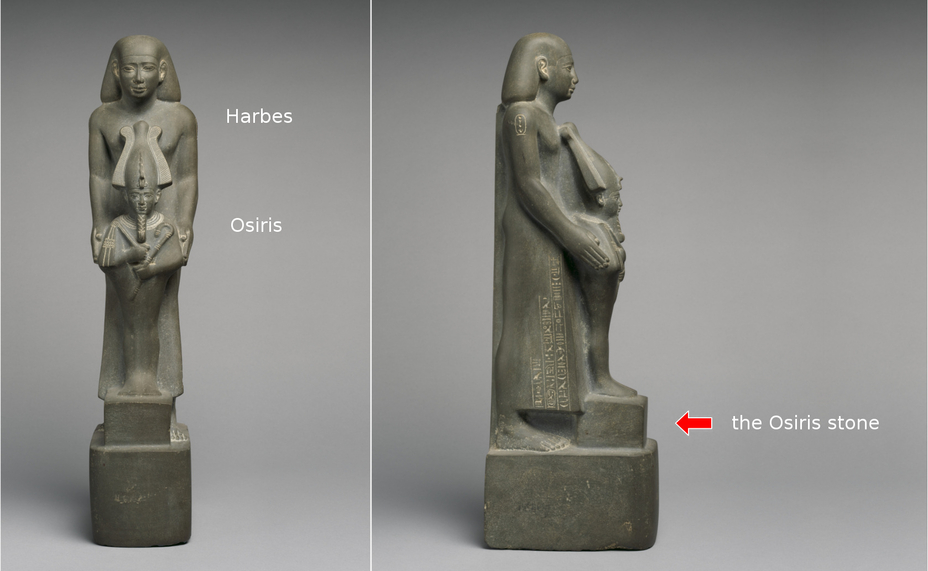
"Statue of Harbes, called Psamtiknefer, son of Ptahhotep. Harbes was an official of the pharaoh Psamtik II. This statue depicts him protecting a figure of the god Osiris. Harbes wears the king's two cartouches on either shoulder. The statue was anciently set up in Karnak Temple at Thebes, where it constitutes a rare example inscribed for this king". Accession Number: 19.2.2. Late Period, Saite, 595–589 B.C. at the Metropolitan Museum of Art, MET New-York: https://www.metmuseum.org/art/collection/search/546748
33.21 Harbes represented lifting (the) Osiris (stone)
Again, same principle as we've already seen plenty of times now: Osiris is represented here twice, first in his human form, and second in its original form, the Osiris stone.
Also, the gesture of Harbes isn't of a man protecting Osiris like indicated by the MET, but that of a man who is lifting Osiris. The statue is about Harbes being able to lift the Osiris stone.
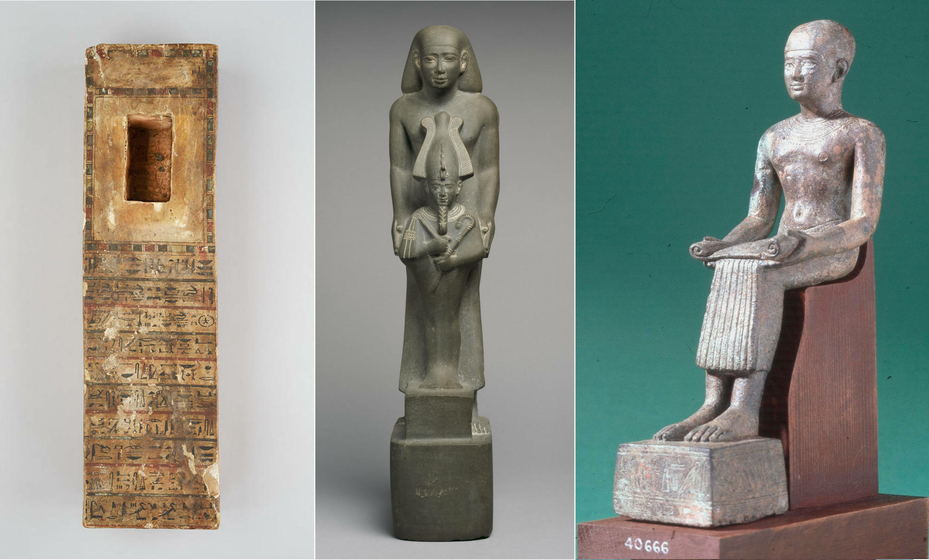
Wooden base of a Ptah-Sokar-Osiris figure at the MET, dedicated to a temple musician named Ihet; it is inscribed with offering prayers and texts glorifying the gods : https://www.metmuseum.org/art/collection/search/553823
Bronze seated figure of Imhotep EA40666 at the British Museum: https://www.britishmuseum.org/collection/object/Y_EA40666
33.22 It probably is Imhotep who designed the Osiris stone
Most probably many counter weight systems such as the composite impactor of the Great Pyramid would have been produced, and for many different reasons, because at the end of the day the lifting of the impactor is simply a way of accumulating energy, that you can use for many applications; but the impactor of the Great Pyramid, with its ramming capabilities and designed to pressurize both air and water, would have been without any doubt the most important of all, and its weight, the Osiris stonet had probably been designed and calibrated by the great Imhotep himself.
The above representation of Imhotep, both "seated" and "levitating" on a single block of stone, is certainly the glorification of the fact that it really was Imhotep who designed not only the Osiris stone of the Great Pyramid, or the composite impactor unit, but probably the entire operating process of the Pyramid.
"Set hated his brother Osiris, and he gathered to himself seventy-two conspirators […]. And they made a plan that when Osiris returned they should kill him and place Set on the throne; but they hid their plans, and with smiling faces went out to meet Osiris when he re-entered Egypt in triumph."
"In secret they met again and again, in secret also they prepared a coffer made of costly wood painted and decorated with rich designs and glowing colours […]. Set, that Wicked One, had in secret measured the body of Osiris, and the coffer was made to fit the body of the King, for this was part of the plan."
"One after one, the conspirators lay down in the coffer with jests and laughter; for one it was too long, and for another it was too short, and for a third it was too wide, and for a fourth too narrow. Then came Osiris to take his turn, and he, all unsuspecting, lay down in it. At once the conspirators seized the lid and clapped it on; some nailed it firmly in its place, while others poured molten lead into all the openings lest he should breathe and live. Thus died the great Osiris."
"The conspirators lifted the chest, which was now a coffin, and carried it to the river-bank. They flung it far into the water, and Hapi the Nile-god caught it and carried it upon his stream to the sea".
Excerpts are from Sacred Texts: https://www.sacred-texts.com/egy/ael/ael08.htm#page_41
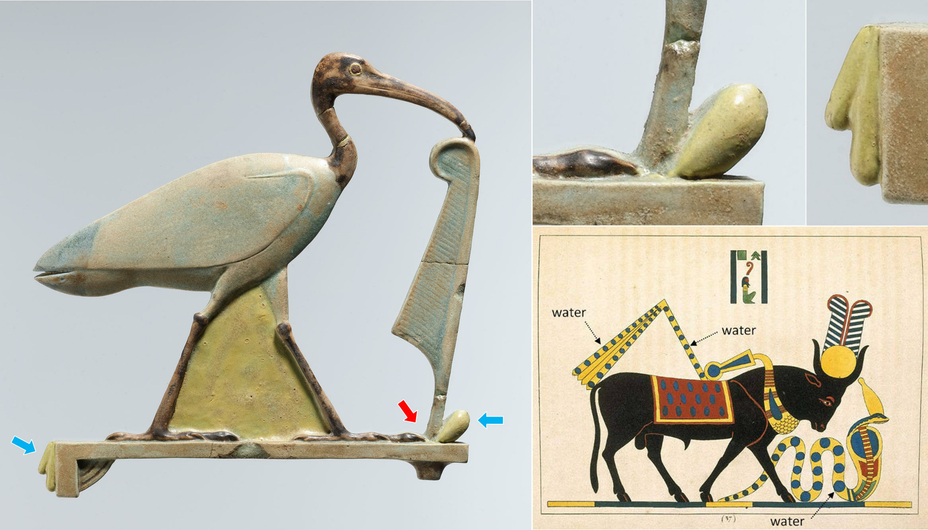
"Inlay depicting Thoth as the ibis with a maat feather", Accession Number: 26.7.992 at the Metropolitan Museum of Art, New-York: https://www.metmuseum.org/art/collection/search/544093
The Apis Bull, also Api or Hapi (Apis, Taureau Consacré a la Lune)", 1823-25, by the French illustrator Léon-Jean-Joseph Dubois, at the Brooklyn Museum: https://www.brooklynmuseum.org/opencollection/archives/image/55326
33.23 The representation of the water used to operate the sledge runners
We've already seen with the Apis bull (Section 31.02), how ancient Egyptians have beautifully represented the projections of water accompanying the fall of the impactor in the central caisson of the Gallery: they used the Apis bull in his ramming position, and they added an "undulating" snake who literally looks like "pushed" in front of the bull by his two front hooves, as a representation of the water projected in front of the impactor and perfectly mimicking water ripples that would have been created in front of the impactor; and they added projections of water directed towards the back of the bull as a representation of huge water plumes that were projected behind the path of the impactor.
Because the runners were also moving into tracks covered with water, there also was water pushed in front of the runners' path and behind it; this is why we have these little "drops", pushed by the front toes of the ibis Thoth and falling at the back of the bird.
33.24 The balance of the sledge runners onto the water of the tracks
One way of describing the operation of the runners, would be to say that they were like "floating" onto the water which was present into the tracks, and that is probably explaining why the ibis bird is in "balance" onto the feather of Maat, on why that feather is originating from the base of the big "water drop".
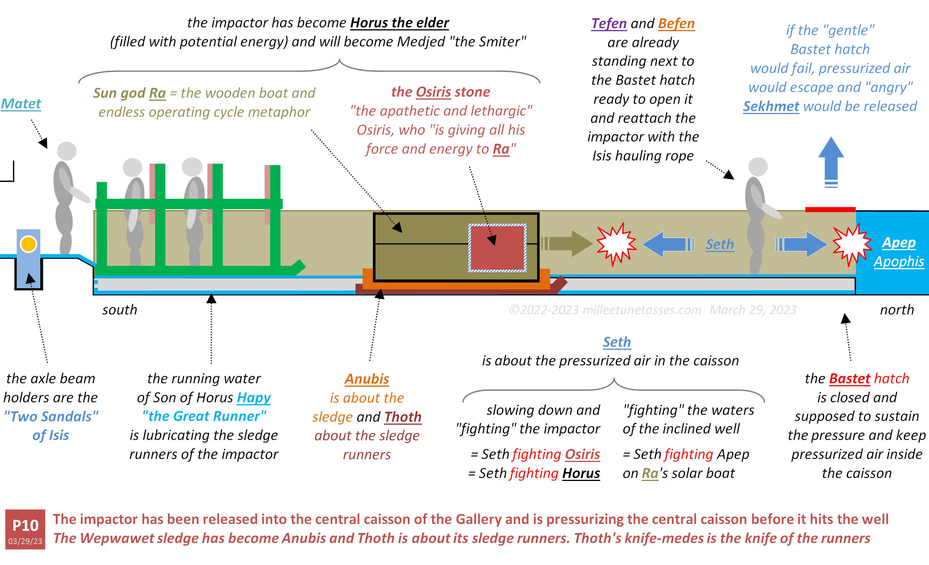
33.25 Operation of the Grand Gallery of the Great Pyramid of Egypt, Position P10 Side View
The impactor has been released into the central caisson of the Gallery and is pressurizing the central caisson before it hits the well. The Wepwawet sledge has become Anubis and Thoth is about its sledge runners. Thoth's knife-medes is the knife of the runners. Last updated March 29, 2023. All the operating phases of the Grand Gallery's functioning in Section 31.
33.26 The connection between Thoth and the Great Serpent Apep (Apophis)
In the following excerpt, the "sky boat which crossed the heavens by day" is the impactor moving up and down the Grand Gallery, and the great serpent Apophis is the dark waters of the inclined well:
"Thoth was given a seat of honor in the sky boat which crossed the heavens by day and, by night, Thoth helped to drive away the serpent Apophis who sought to destroy the sun god." https://www.worldhistory.org/Thoth/#google_vignette
33.27 The equilibrium between the impactor Horus and the pressurized air Seth
I can't imagine all the work and trials that would have been implemented in the Great Pyramid's design, so that everything would work properly, in a perfect balance: the slope of the Gallery, its length, the weight of the Osiris stone, the speed of the impactor when it had to ram into the inclined well waters, etc.
One of these adjustments would have to deal with the efficiency of the sledge runners in their sliding capacities and their ability to fight the pressurized air that the impactor created during its fall; or if we use the ancient Egyptian way of describing it: the fight between Horus (the impactor, as Horus the elder) and Seth (the pressurized air).
This fight, or rather this equilibrium between the two deities, is what the following excerpt is all about:
"Thoth is the scribe who records the events of the contest and offers advice to the gods. He heals both Horus and Set at different times in their battle in order to make sure that both sides are equally capable and none can gain advantage over the other so that the contest will be fair." https://www.worldhistory.org/Thoth/
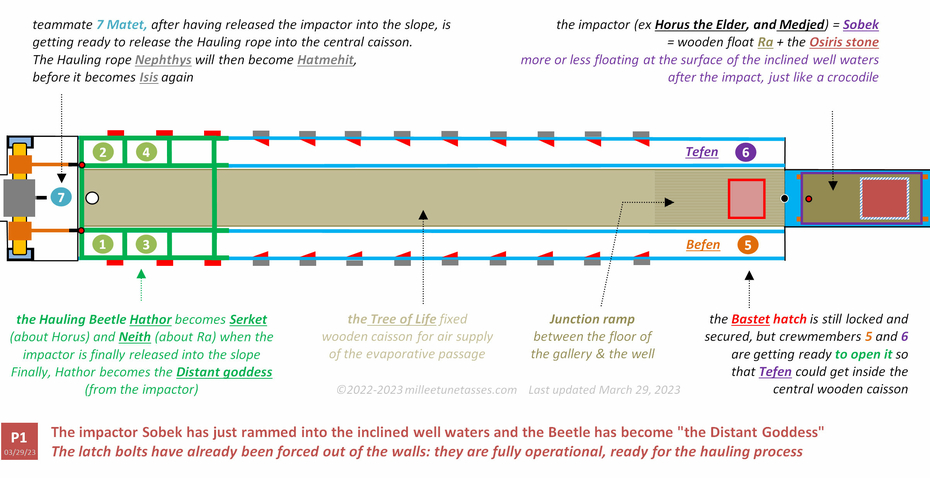
33.28 Operation of the Grand Gallery of the Great Pyramid of Egypt, Position P1
The beginning of a new cycle of hauling and pressurization. The impactor Sobek has just rammed into the inclined well waters and the Beetle has become "the Distant Goddess". The latch bolts have already been forced out of the walls: they are fully operational, ready for the hauling process. Last updated March 29, 2023. All the operating phases of the Grand Gallery's functioning in Section 31.
33.29 How long was the Great Pyramid really in operation (highly hypothetical)
We've already discussed in Section 32.36 the (highly hypothetical) hypothesis that the Great Pyramid would have been in operation for 7 years (3 years under Khufu and 4 years under Khafre); but in the following excerpt appears another mention that could also directly refer to the operating period of the pyramid (again, this is highly questionable).
Nethertheless, when it is said that Thoth had to "fetch the Distant goddess" 1077 times, it is hard not to be inclined into associating these 1077 times, to the number of times that the impactor' sledge runners had to be reunited with the waiting Hauling beetle, at the top of the Grand Gallery.
So, was the Great Pyramid operated for 1077 complete cycles? Maybe it was...
"He [Thoth] was so important to the gods, and especially to Ra, that he was the god chosen to retrieve Ra's daughter from the distant lands she sometimes fled to. […] The motif of The Distant Goddess appears in a number of Egyptian myths but always has the same meaning no matter who the specific goddess is or where she has gone: Ra's daughter disagrees with him on some matter and leaves him to vanish into some far off land and someone has to be sent to bring her back […] Ra chose Thoth to fetch this Distant Goddess back from a remote desert. Disguised as a baboon or monkey, Thoth accomplished his task through humility, cunning, and perseverance. According to one account he had to ask the goddess to come home 1,077 times." https://www.worldhistory.org/Thoth/#google_vignette

33.30 The baboon Thoth "peeing" inside the Grand Gallery
There is another extraordinary thing here with this representation of Thoth as a baboon from the Louvre.
Remember that the Son of Horus Hapy is the deification of the water that was running through the Grand Gallery and that Thoth is the glorification of the sledge runners of the impactor, but also the glorification of the part of Hapy which was in direct contact with the runners.
I actually had some difficulties trying to understand the exact meaning of both Hapy and Thoth, until I remembered that ancient Egyptians used to think more in a "functional" way, rather than a "anatomical" way.
What I mean to say is that both Hapy and Thoth are about the water running through the central caisson of the Gallery, but probably Hapy has to be seen as the water in an "anatomical" way, when Thoth has to be seen as the part of that water which was interacting with the sledge runners and forming an indissociable "couple": the sledge runners + the water needed to operate these runners.
Another way of saying that, is that the water which empowered the fully operational sledge runners formed the deity Thoth, and that this water was originating in the Hapy water.
Anyway, except for the proportions (the width of each ramp is 1 cubit, when the central gutter is 2 cubits), the "structure" on which is sited Thoth is without any doubt the representation of the Grand Gallery… and Thoth is like peeing in the central gutter. Difficult to be more explicit!
The important information here, if it has to be taken literally, is that both the gutter and the ramps look like they both supported some kind of stairs. We've already seen in previous Section 32 that the central gutter was probably covered with some kind of horizontal "sticks" just like the modern log flume ride chutes, and I would say that the ramps would simply have some kind of "stairs", which would have been probably needed for the crewmembers of the Hauling beetle to be more efficient.

Ski jumping at the 2020 Winter Youth Olympics "Simen Markeng juste avant son saut", by DarDarCH: https://commons.wikimedia.org/wiki/File:Ski_jumping_at_the_2020_Winter_Youth_Olympics_-_20_January_2020_-_31.jpg#/media/File:Ski_jumping_at_the_2020_Winter_Youth_Olympics_-_20_January_2020_-_31.jpg
33.31 The "straight and true like Thoth" metaphor
I first want to point out that I hope there is no misunderstanding about all these modern sport or leisure activities I'm using to illustrate the metaphors that ancient Egyptians created in their own way to glorify how was operated the impactor of the Great Pyramid.
I'm not saying ancient Egyptians had log flume rides or that they were ski jumping, these are only metaphors of our own modern time.
That being said, the ski jumping or ski flying metaphor is probably even better than all the other metaphors I personally used, or ancient Egyptian themselves did use for that matter.
The thing is that the impactor would have been able to slide and gain speed no matter what, with the only requirement that water would have been used to reduce the friction between its structure and the floor of the central caisson; but if it wouldn't have been "guided" into perfectly "straight lines", it would have reduce its efficiency and even could have most certainly ended very badly.
In other words, the Anubis sledge had to have runners, and they would have to be set into some kind of tracks.
"In vignettes of the Book of the Dead [Thoth] stands before the scales which weigh the heart of the deceased and record the verdict. This role gave Thoth a reputation for truth and integrity and is seen in the common assertion that a person had conducted his life in a manner "straight and true like Thoth". https://www.worldhistory.org/Thoth/#google_vignette
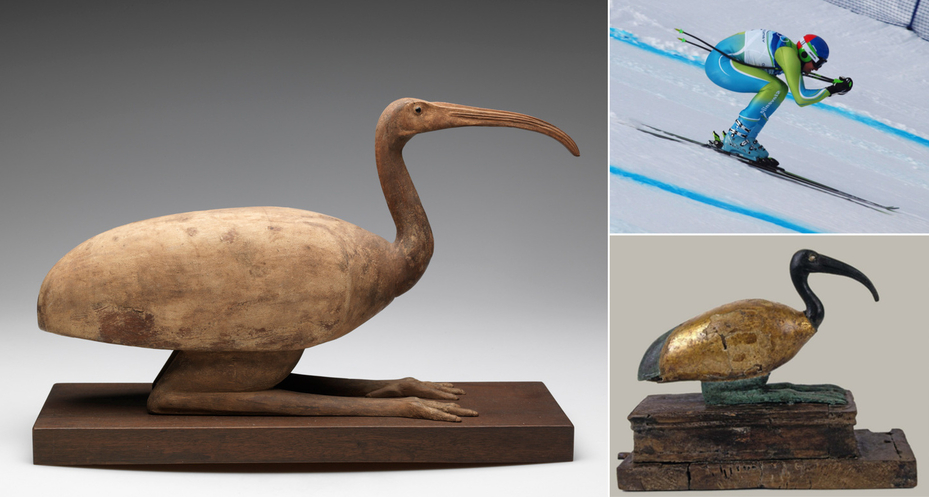
"Slovenia's Andrej Šporn at the 2010 Winter Olympics downhill in a typical downhill body position", by Jon Wick: https://en.wikipedia.org/wiki/Downhill_%28ski_competition%29#/media/File:Andrej_%C5%A0porn_at_the_2010_Winter_Olympic_downhill.jpg
33.32 The perfect aerodynamic look of the legs of Thoth as an ibis
Every time I look at the above image of Thoth from the Risd Museum, I can't help myself imagining him in a ski race; doesn't he look like a racer of some kind, designed for speed?
Of course, the unnatural legs of the ibis form of Thoth, are the sledge runners themselves.

"An athlete descending the inrun, with the start gate visible at the top", by Val 202: https://www.flickr.com/photos/val202/16865497746/
33.33 The almost perfect ski jumping model
Just imagine here, that the athlete (the impactor) isn't in plain air but inside a low wooden corridor (the central wooden caisson), and you have a pretty perfect modern reinterpretation of the ancient Egyptian layout of the Grand Gallery, latch bolts "included".
Of course the "latch bolts" here don't have the same purpose than in the Great Pyramid, they are just here to adjust (in a discontinuous way like in the Gallery) the starting point of the jump, but it is funny anyway just to make the remark.
You even have the two lateral ramps (not for hauling anything though) on each side of the jumping tracks, just like in the pyramid… "remarkable"!
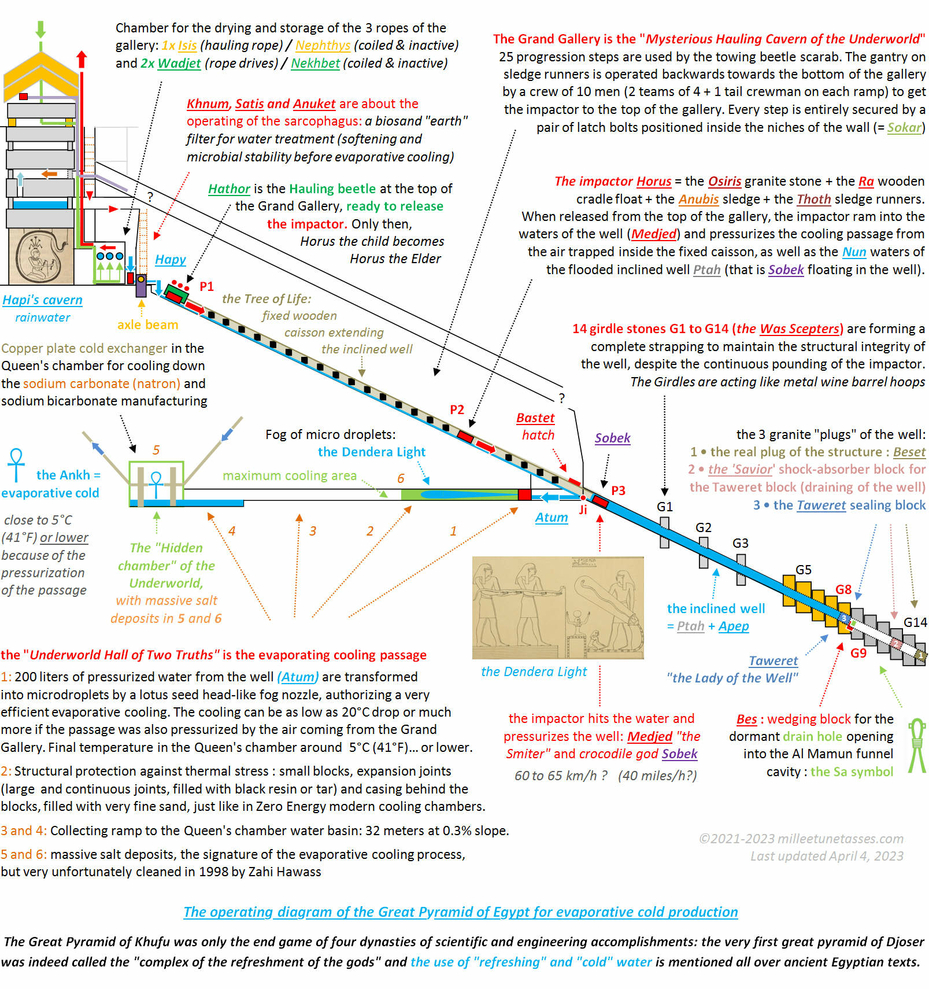
33.34 Operation of the Great Pyramid of Egypt for evaporative cold production, hypothetically for the cooling of a Solvay chemical manufacturing of sodium carbonate (natron)
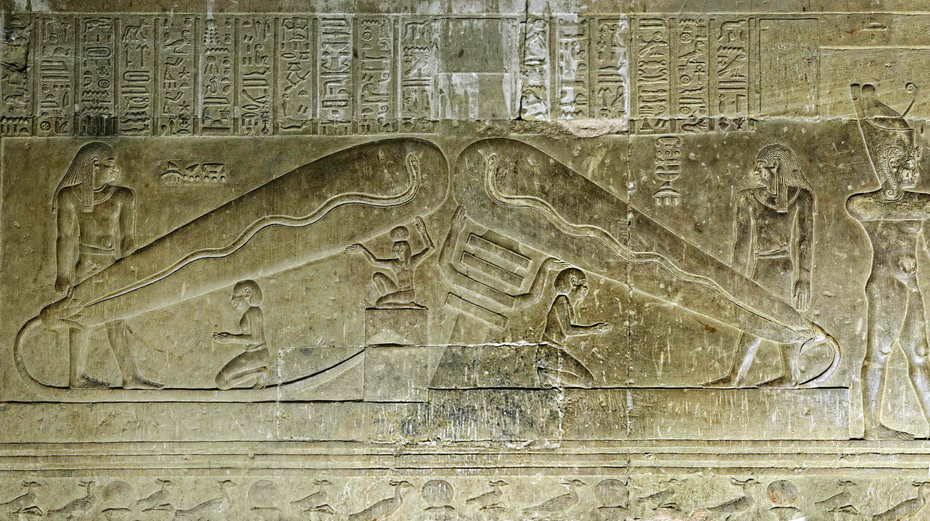
Photograph of the Dendera Light thanks to Kairoinfo4U: https://www.flickr.com/photos/manna4u/14525094039/in/photostream/
33.35 The Dendera light is the fog of water that created the evaporative cold
Even if all the physical work occurred in the Grand Gallery of the Great Pyramid with the operating of the Hauling beetle, the magic happened in the horizontal cooling passage with the creation of a fog of microdroplets from the pressurized water generated inside the inclined well (more on the Dendera Light in Section 2).
The Dendera Light is that fog.
33.36 Summary of the study: hidden behind the academic vision of the ancient Egyptian religion, a vast number of metaphors are describing some of the most advanced science and technological knowledge of that time : ancient Egyptian gods were nothing else than pharaohs' metaphoric self-glorifications of their theoretical and experimental scientific accomplishments in physics and chemistry.
Pharaohs used the power of Science to legitimate themselves as kings of Egypt : they forged an entire religion, based on science to rule their kingdom, and they presented that science as Magic.
The end game of this technological program that probably started on the very first Dynasty, was the Great Pyramid of Giza where evaporative cooling was engineered in the known part of the pyramid from the pressurized water produced in the inclined well, known today as the ascending passage.
The evaporative cold simply took advantage of the power of water, and was most probably necessary to cool down chemical manufacturing of sodium carbonate and sodium bicarbonate produced by an ammonia-soda Solvay process, as suggested by the very strong ammonia smell and the limestone kiln in the so-called burial chamber of the Red Pyramid. At that time, sodium carbonate was called natron, and it was the salt used for the mummification of the pharaohs (Sections 14, 15 and 16).
The cooling seems to have represented the most difficult part of the process, as suggested by the Step Pyramid's official name : according to scholars, the very first pyramid complex, the Step Pyramid of Djoser, was called "the refreshment of the Gods". No doubt that a more accurate translation would certainly be "the cooling of the Gods".
It means that ancient Egyptians were the first civilization to master a Solvay-like process for sodium carbonate manufacturing, long before it got reinvented in the 1800's in Europe. The key elements of that process is the temperature control of the chemical reactions (the cooling), and the dome shaped plate necessary for the counterflow chemical reactions to occur in an efficient way. That counterflow reaction plate is what really is the disc of Sabu.
As shown with Akhenaten and Nefertiti, the creation of the evaporative cold was the most sacred accomplishment of all (Section 17), and this is exactly what the Dendera Light is all about : the Dendera Light is the fog of microdroplets of liquid water that evaporates and creates the cold. Talking about the snake inside the Dendera Light Bulb : "The field surrounding Ra’s snake form is referred to in ancient Egyptian literature as protective magical energy in liquid form that all gods and pharaohs possess" (Faulkner, Section 2).
Everything that had been done in the Great Pyramid of Giza inspired most of the ancient Egyptian religion, and it had been glorified into what we know today as the Underworld.
The Underworld is referring to the chambers and passages of the Great Pyramid of Khufu, and in particular to the Grand Gallery where a hauling gantry beetle operated a wooden coffin shaped impactor that had a small nested granite block inside it. The impactor generated endlessly, over and over, maybe every 15 minutes the pressurized water that was then transformed into a fog of microdroplets inside the horizontal cooling passage.
The Grand Gallery of the Great Pyramid where the act of hauling was done, is the "Secret Hauling Cavern of the Underworld" described in the Amduat "Book of the Hidden Chamber".
The most important chamber of the Great Pyramid wasn't the King's chamber that only was the main water tank of the pyramid, but the Queen's chamber, the only one on the central axis of the pyramid. Because the Queen's chamber was inaccessible from the rest of the pyramid, it was glorified into the "Hidden Chamber of the Underworld" (Section 11), and because the Queen's chamber was the coolest place in the pyramid (about 5°C / 41°F), and with a constant 100% Humidity rate, this chamber was the one where the biggest amount of very hard salt encrustation had been documented by the first explorers of the pyramid in the 1800's and before it had been removed in 1998 by Zahi Hawass (Section 1). Very hard salt encrustation is the signature of the evaporative cooling process, even nowadays.
The most incredible thing is that pretty much everything I've just said, actually appears in many myths, and they don't even originate from ancient Egypt : the "Churning of the Ocean" Hindu myth that produces the immortal nectar Amrita, the Tibetan Prayer Wheels operated to give small amounts of 'merit' to too lazy Naga snakes, and the entire Norse mythology with Thor's magical hammer endlessly fighting another Great Serpent of the Underworld and producing a mist of cold from a mysterious well that would be opposed to hellishly hot heat waves.
I'm talking a lot about the impactor of the Great Pyramid, but it is nothing compared to the tremendous impact caused by what the ancient Egyptians had accomplished within the 78 years of the Great Pyramids Era, from Djoser to the Great Pyramid: the entire ancient World had been shaken up in their deepest beliefs beyond all comprehension; and we are still talking about it today.
Poster un commentaire
